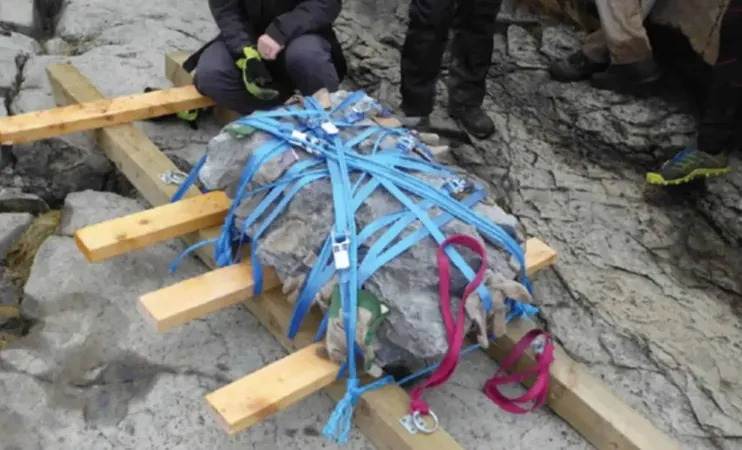
Stunning Discovery: 166-Million-Year-Old Dog-Sized Dinosaur Fossil Unearthed in Scotland
2025-05-16
Author: Ting
A Jurassic Marvel Found on the Isle of Skye
In a groundbreaking revelation for paleontology, scientists have uncovered a remarkably intact juvenile dinosaur skeleton on the Isle of Skye, Scotland, dating back around 166 million years. This fossil is not only the first but also the most complete partial dinosaur skeleton from the Middle Jurassic period ever discovered in Scotland, shedding light on an often-overlooked chapter in dinosaur evolution.
Meet Scotland’s Ancient Herbivore: The Dog-Sized Dinosaur
This newly identified dinosaur was roughly the size of a large dog and likely roamed bipedally as a herbivore. Excavation proved treacherous, with the skeleton hidden in hard limestone along a rocky coastline only accessible at low tide. Dr. Elsa Panciroli, a paleobiologist at National Museums Scotland, explained that this find highlights a significant evolutionary period, as dinosaurs transitioned from small bipedal carnivores and omnivores of the earlier eras to a vast array of species, some of which evolved into the largest land animals ever.
A Rarity Unveiled: Scotland’s Middle Jurassic Fossil Record
Fossils from the Middle Jurassic are exceedingly rare and often only consist of fragmented remains. The discovery of this nearly complete skeleton from the Kilmaluag Formation—an area previously known for yielding minimal dinosaur fossils—marks a pivotal moment. Dr. Panciroli noted that if this specimen turns out to be an ornithischian—a group of plant-eating dinosaurs—it represents a significant finding, being the geologically youngest occurrence in Scotland and the first from this particular formation.
Extracting Secrets of the Dinosaur’s Life Cycle
The painstaking process of extracting this fossil involved drilling, wedging, and carefully lowering a heavy limestone block from a sheer cliffside, all while adhering to strict conservation measures due to the site’s protected status. Through the analysis of its bone tissue, researchers discovered growth rings akin to those in trees, which suggested that the dinosaur was at least eight years old when it passed away. Its bones displayed signs of continued but slowed growth, indicating it was a subadult on the brink of maturity.
Shifting Our Understanding of Early Herbivores
Should this fossil be confirmed as belonging to the ornithopods—a lineage that includes well-known herbivores like Iguanodon—it could potentially rewrite the history of these dinosaurs as the earliest known body fossil of an iguanodontian. Prior evidence of these dinosaurs in the Middle Jurassic was limited to footprints, making this discovery monumental. It not only pushes back the timeline for the emergence of these crucial herbivorous dinosaurs but also enriches our understanding of the ecosystems in which they lived.
This extraordinary find emphasizes the importance of further exploration in Scotland's fossil-rich deposits, as each discovery adds pieces to the intricate puzzle of our planet's prehistoric life.



 Brasil (PT)
Brasil (PT)
 Canada (EN)
Canada (EN)
 Chile (ES)
Chile (ES)
 Česko (CS)
Česko (CS)
 대한민국 (KO)
대한민국 (KO)
 España (ES)
España (ES)
 France (FR)
France (FR)
 Hong Kong (EN)
Hong Kong (EN)
 Italia (IT)
Italia (IT)
 日本 (JA)
日本 (JA)
 Magyarország (HU)
Magyarország (HU)
 Norge (NO)
Norge (NO)
 Polska (PL)
Polska (PL)
 Schweiz (DE)
Schweiz (DE)
 Singapore (EN)
Singapore (EN)
 Sverige (SV)
Sverige (SV)
 Suomi (FI)
Suomi (FI)
 Türkiye (TR)
Türkiye (TR)
 الإمارات العربية المتحدة (AR)
الإمارات العربية المتحدة (AR)